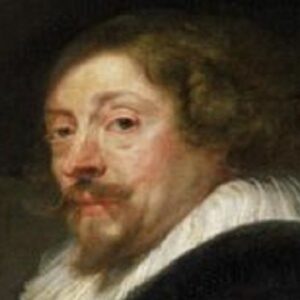Peter Paul Rubens was a Dutch painter who became one of the most influential Baroque painters of his period, as well as a diplomat for European royal families. Rubens was born into a powerful family; his father was a lawyer for William I of Orange’s house, and his mother was an author. Rubens traveled to Antwerp with his mother after his father’s unexpected death, where he was trained in humanism before becoming an apprentice to some of the most well-known Mannerist painters of the day. Rubens became a well-known painter and moved about Europe as his art became more in demand among the continent’s royal families. On the other side, he worked as a diplomat and was recognized for his achievements by the Spanish and English royal families. Finally, but certainly not least, Rubens maintained an Antwerp studio where he recruited assistance and educated aspiring painters. As his reputation as a well-known painter grew, so did the number of outstanding paintings produced by the students in that studio.
Childhood and Adolescence
On the 28th of June, 1577, Peter Paul Rubens was born in Siegen, Germany. Jan Rubens, his father, was a well-known lawyer, and Maria Pypelincks, his mother, was an author. He was one of six siblings.
A year after his birth, his family moved to Cologne. However, historians claim that Rubens was raised as a Catholic and that religion had a significant impact on his career as an artist.
His father died in 1587, and the family migrated to Antwerp two years later. He received a humanist education as well as languages and classics in the new city.
Rubens began his art apprenticeship at the age of 14 under the supervision of Tobias Verhaeghe. Later in his career, he worked as an apprentice to Mannerist painters Adam von Noort and Otto van Veen. In 1598, he was appointed master of the Guild of St. Luke.
The Career of Peter
In 1600, he traveled to Italy and stayed mostly in Venice and Rome, studying the works of Tintoretto and Titian, among others. The Duke funded his trip to Florence so that he might learn more about traditional Roman art. He painted the altarpiece ‘St. Helena with the True Cross’ at the Roman Church of Santa Croce in Jerusalem around this time.
After spending a year in Spain on a diplomatic mission, Peter Paul Ruben returned to Italy in 1604 and lived in Genoa, Mantua, and Rome during his four-year stay.
‘Marchesa Brigida Spinola-Doria’ and ‘Portrait of Maria di Antonio Serra Pallavicini’ were among the pieces he created while in Italy. Rubens was also commissioned to work on the high altar of Santa Maria church in Vallicella, which was one of his most significant works.
In 1609, he relocated to Antwerp due to his mother’s illness. The Archduke of Austria, Albert VII, and the Infanta Isabella Clara Eugenia of Spain appointed Rubens as their court painters in the same year. In Antwerp, he opened a studio where he taught students and employed a number of assistants.
‘The Raising of the Cross’ and ‘The Descent from the Cross’ are two prominent works from the time period, and he also made prints of his works in partnership with a well-known publisher, further enhancing his renown.
After being summoned to Paris by Marie de Medici, the Queen Mother of France, to create paintings linked to her life, he was entrusted with diplomatic tasks by the Habsburg rulers from Spain from 1621 onwards. Rubens painted the Marie de Medici Cycle while also serving as a diplomat and gathering intelligence. In his capacity as a diplomat, he also visited England.
After elevating Rubens to nobility, Philip IV of Spain entrusted him with even more diplomatic responsibilities, and during his stay in Madrid in 1628, he created a copy of Titian’s ‘Fall of Man.’ Following that, he traveled to London, England, where he made one of his most famous works, ‘Allegory of Peace and War.’ By that time, he had established himself as a powerful artist and a master painter.
Around 1630, Peter Paul Ruben returned to Antwerp, where he spent the majority of his time completing assignments such as the paintings on the ceiling of Whitehall’s Banqueting House.
Rubens created works for the Spanish royal family during this decade, including ‘The Feast of Venus,’ ‘The Three Graces,’ and ‘The Judgement of Paris.’
For his exploits, Charles I knighted him in 1630.
Peter’s Major Projects
During his career as a painter, Peter Paul Rubens created a huge body of work. However, it was a long-lost artwork that became particularly well-known. The picture in question is titled ‘Massacre of the Innocents,’ and it was sold for an astounding $76.2 million at an auction in 2002.
Personal History and Legacy
On October 3, 1609, Rubens married Isabella Brant. His wife came from a prominent Antwerp family, and the couple had three children. After their marriage, Isabella died 17 years later.
Rubens married Helene Fourment in 1630, who happened to be his first wife Isabella Brant’s niece. They had five children together.
Peter Paul Rubens had suffered from gout for a long time, which contributed to his death on May 30, 1640, from a fatal heart attack.
Estimated Net worth
Peter is one of the wealthiest painters, as well as one of the most popular. Peter Paul Rubens’s net worth is estimated to be $5 million.


